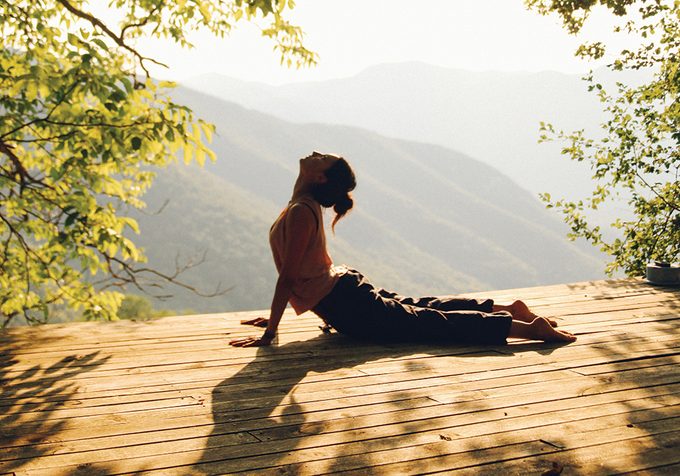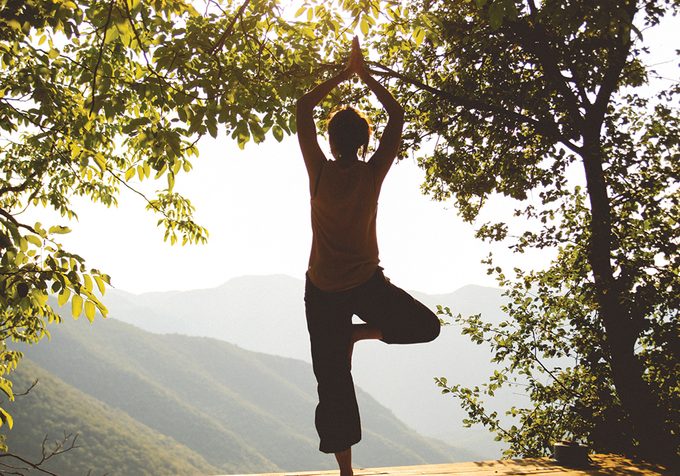Stress Less With Eco-Yoga: Why You Should Take Your Yoga Practice Outdoors
Walking meditation combined with yoga in the woods – sounds a little “out there,” but it could be just the stress antidote you’ve been looking for.

I should’ve been stressed: Deadlines loomed large, my wallet was stolen the day before and, most worrisome, my dog had just been put on antidepressants. Yet, as I attempted tree pose in an endless forest outside of Canmore, AB, I was able to leave all that behind. It was a workday, but it no longer felt like one. I was able to centre myself again with a spot of eco-yoga.
Derived from the Japanese practice of Shinrin-yoku, or forest bathing, eco-yoga is an outdoor spa treatment for the soul – and, boy, did mine need soothing. My go-to coping strategies (a bath, a goblet of wine and hot yoga, not necessarily in that order) just weren’t cutting it. Instead, I met up with Ronna Schneberger, a certified guide and yoga instructor in Canmore who teaches folks how to reconnect with themselves in nature.
Taking your yoga practice outside
In recent years, there has been an increasing trend to practise outdoor yoga and even take your mat on a hike, but eco-yoga goes beyond that. It’s about exploring our deep (and often forgotten) connection with nature. It has its roots in yogic traditions, Buddhist teachings, forest bathing and various yoga styles. In Western cultures, we tend to associate yoga with the poses we do in a studio, but some gurus have found powerful ways to layer yoga with mindful moments outdoors, and Schneberger is one such pioneer.
Though we live in a country blessed by nature, many of us don’t know how to get off the beaten path. Even if we do, creating a nourishing experience in the great outdoors seems beyond our reach. Yet, studies repeatedly show that being in nature has many benefits, from increasing the activity of cancer-fighting cells to lowering blood pressure. According to a 2012 study, memory and attention span increase by 20 percent after being outside for two hours or longer.
Urbanization is associated with increased levels of mental illness and, today, eight in 10 Canadians live in urban areas. The Canadian Parks Council’s 2014 report, Connecting Canadians with Nature, estimates that we spend 90 percent of our time indoors – much of that tethered to a screen. Thanks to our sedentary lifestyles, we’ve become increasingly disconnected from the natural world. Going for a walk with a neighbour or taking the kids to the park competes with other tasks on our to-do-lists.
Relaxing and recharging with eco-yoga
By combining walking meditation with yoga, practitioners are able to better manage stress and reach moments of clarity. Eco-yoga is ideal for those who enjoy yoga but are looking to experience something deeper. It also helps outdoor enthusiasts connect with nature in a powerful way. Going through a big transition or something stressful? Eco-yoga is nature’s prescription to cultivate more calm in your life.
My experience begins with sense meditation before meandering along the Grassi Lakes Trail outside of Canmore.
Eyes gently closed, I inhale the crisp alpine air while envisioning my senses opening before exhaling the busyness of my mind. While working my breath, I’m reminded by Schneberger that the trees breathe in as I breathe out. I’m part of the photosynthesis process, and that feels pretty rad.

After our meditation, we begin walking ever so slowly under canopies of trees at a pace where we can be fully present (that’s about one-quarter of our regular speed). A component of the eco-yoga experience, walking meditation helps you tune into a zen-like state while physically moving to a serene spot where you’ll flow through yoga poses.
Walking along the trail and taking the time to pause and tune into my senses, I see it anew. I’ve hiked this area before, but how haven’t I noticed that deep russet hue of the pine needles littering the ground? What else have I been missing?
“Being able to slow down and drink in the landscape is an eye-opener for sure,” says hiking guide and eco-yoga enthusiast Kristi Beetch. “I feel connected to nature in a different way. It almost feels like the mountains and meadows have a heartbeat.”
Connecting with nature
Spacing ourselves out along the trail, there are times when I can’t see anyone around me. It feels like I’m alone in this wildlife corridor, but I’m not worried. Normally, I’d worry about surprising a predator, but for the first time I’m remarkably at ease here in these woods. It feels like home.
“Take this as an opportunity to explore the timeless nature in yourself and the outdoors,” whispers Schneberger as we pause for another sense meditation. “At some point, there’s an inquiry into where I stop and where this place begins. You might not know when and where that’ll happen, but at some point it just becomes oneness.”
Eventually, we arrive at the Grassi Lakes. It’s a brisk morning, so we start with some sun salutations to get the energy flowing. To my surprise, I enjoy the sensation of the ground, feeling tiny stones under my palms. Mats aren’t used in eco-yoga – here in the Rockies, the vegetation is so fragile that laying a mat on the grass is apt to destroy it.
Sufficiently warmed up, we move on to partner and grounding poses. Schneberger customizes each session to the weather, client and location. Despite being a hot-yoga fanatic and moving through these poses on a chilly day, I feel more open and limber.
There are times between poses when we simply sit and reflect. A deep feeling of gratitude washes over me as I take in the emerald coniferous carpet that frames this glassy lake. Absorbing nature’s eye candy, my brain doesn’t flitter off as it usually does. All that matters is being here now. Those city stressors seem oh so far away.




